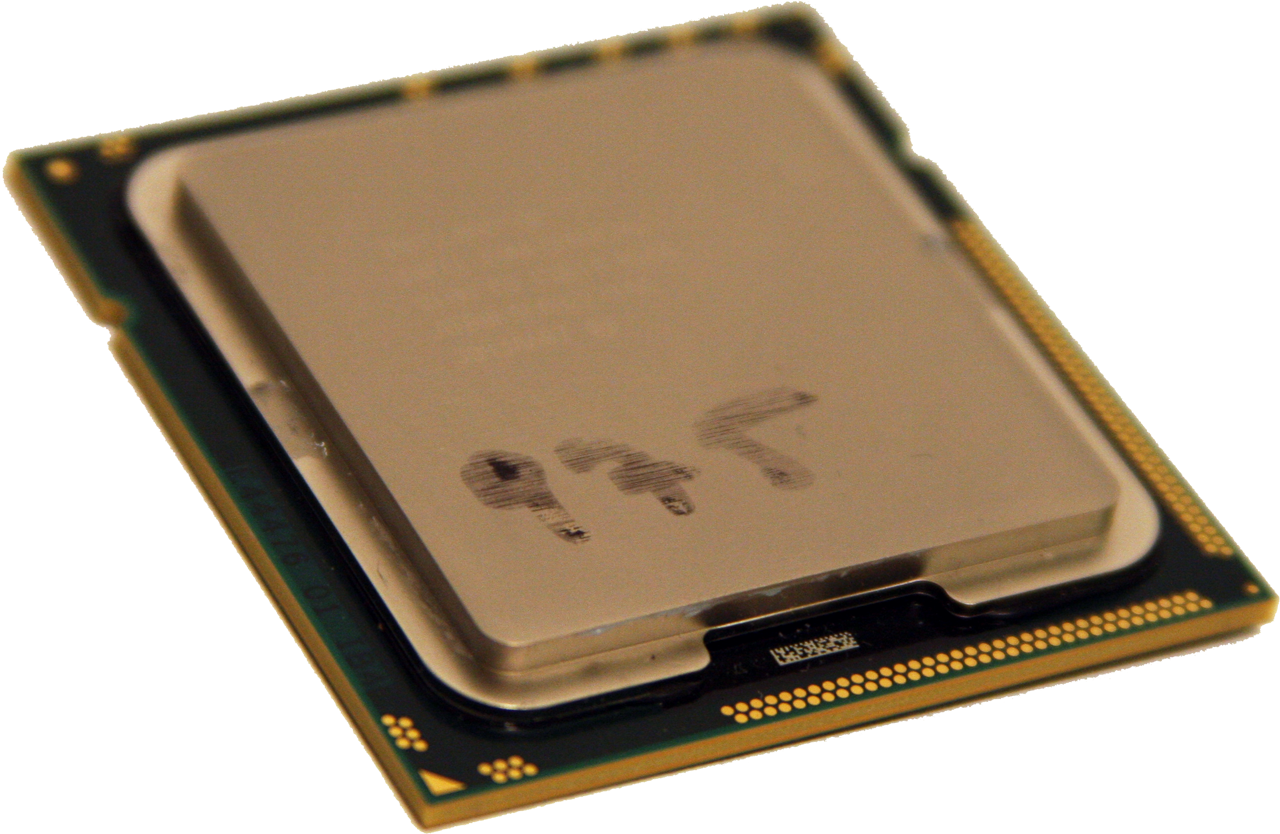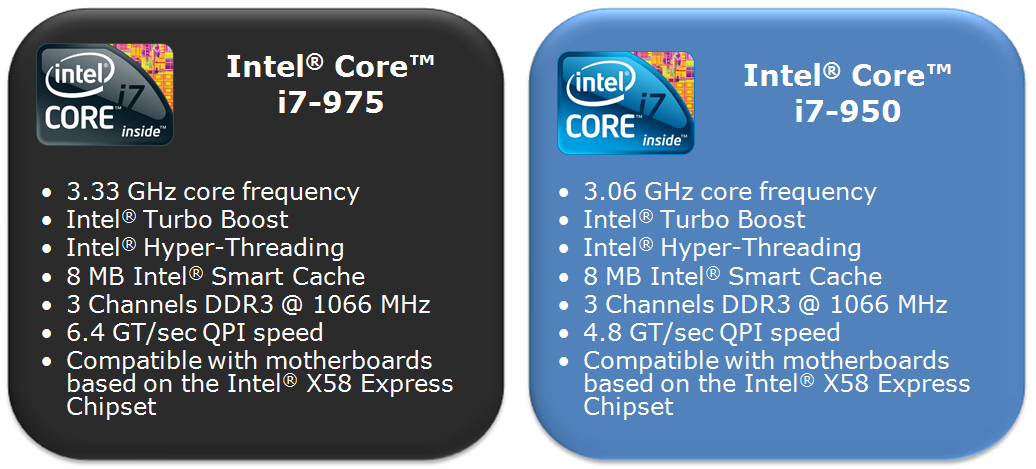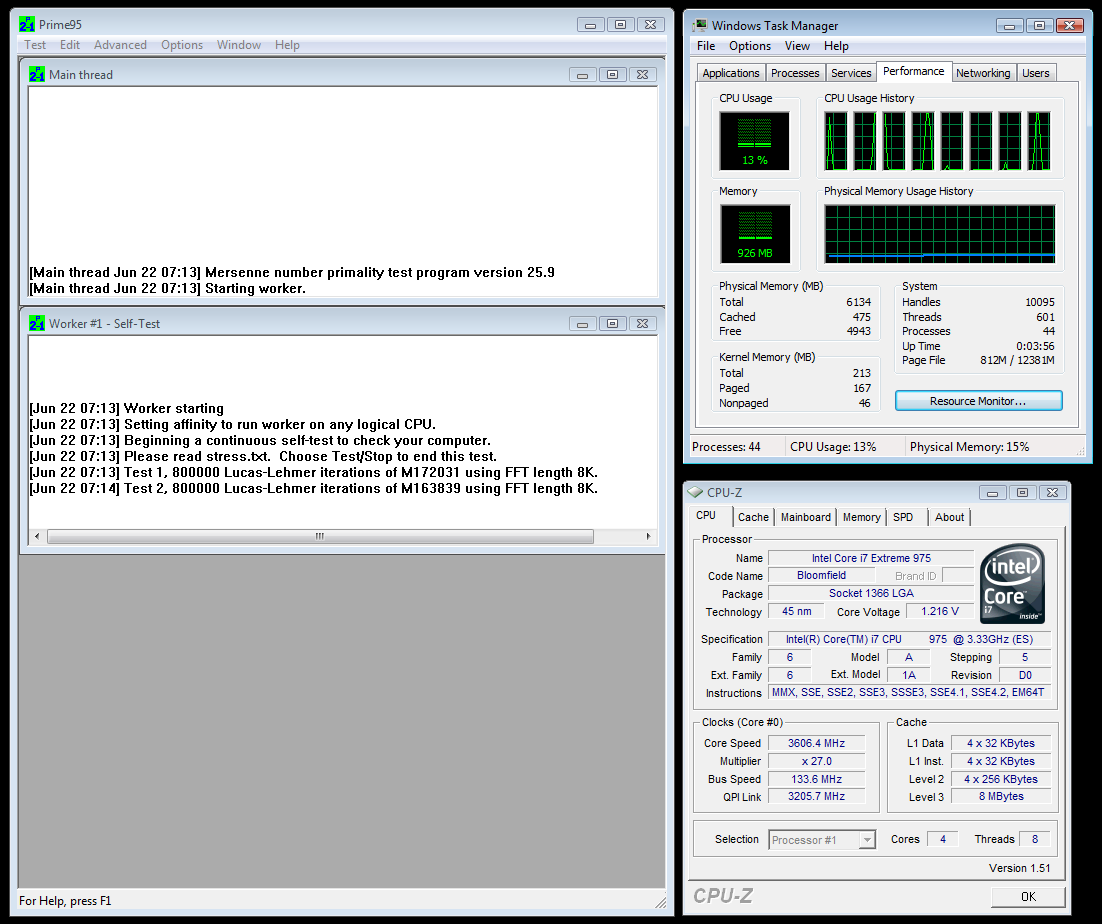Intel Core i7-975 Extreme And i7-950 Reviewed
Core i7-975 Extreme Details
The Core i7 vital stats you already know apply here, just as they have since the architecture launched last year. Manufactured on Intel’s now-mature 45nm process, a single Core i7 die populates 263 square millimeters.
Natively quad-core in that the processor doesn’t consist of two dual-core die on a single multi-chip module (like Core 2 Quad), Core i7 also includes Hyper-Threading technology. The result is a micro-architecture with four physical execution cores able to concurrently work on eight threads. As a result of the efforts expended by software developers to better-optimize relevant code for parallelism, this results in a performance win more often now than it did back when Hyper-Threading first emerged in the Pentium 4 days.
Cache sizes remain the same (32 KB L1 I/32 KB L1 D and 256 KB L2 per core, plus 8 MB shared L3), and the integrated triple-channel memory controller is still officially limited to DDR3-1066. But of course, as we’ve discovered, retail CPUs support the multipliers necessary to reach as far as DDR3-2133. We have heard from one memory vendor that the controller itself has been improved, but without any additional information from Intel regarding how it might have been tweaked, we can’t confirm those rumors at this time. We can say that DDR3-2133 is now within reach, though it takes some serious tuning to stabilize at that data rate.
As with the i7-965 Extreme, the 975 boasts a 6.4 GT/s QPI link, while the i7-950 employs a 4.8 GT/s link. Of course, if you’re running a retail processor (and not an engineering sample, like the one used in our original Core i7 launch coverage), you should be able to manually tune QPI speed up to 6.4 GT/s in your motherboard’s BIOS.
| Header Cell - Column 0 | Core i7-975 Extreme | Core i7-965 Extreme | Core i7-950 | Core 2 Extreme QX9770 | Phenom II X4 955 BE |
|---|---|---|---|---|---|
| Core | Bloomfield | Bloomfield | Bloomfield | Yorkfield XE | Deneb |
| Manufacturing Process | 45 nm | 45 nm | 45 nm | 45 nm | 45 nm |
| Frequency | 3.33 GHz | 3.2 GHz | 3.06 GHz | 3.2 GHz | 3.2 GHz |
| L1 Cache (I / D) | 32 KB / 32 KB | 32 KB / 32 KB | 32 KB / 32 KB | 32 KB / 32 KB | 64 KB / 64 KB |
| L2 Cache | 256 KB/Core | 256 KB/Core | 256 KB/Core | 6 MB/Two Cores (12 MB total) | 512 KB/Core |
| L3 Cache | 8 MB Shared | 8 MB Shared | 8 MB Shared | N/A | 6 MB Shared |
| TDP (W) | 130W | 130W | 130W | 136W | 125W |
| QPI/HT/FSB | 6,400 MT/s | 6,400 MT/s | 4,800 MT/s | 1,600 MT/s | 4,000 MT/s |
| Price | $999 | $999 | $562 | No longer listed | $245 |
We asked Intel about the i7-975's Turbo bin configuration and were told that it is exactly the same as the i7-965 before it. That is to say, when 1, 2, 3, or 4 cores are active, you get 2, 1, 1, and 1 available bin (a bin being 133 MHz). Curious as to how much time our 975 Extreme would spend at 3.6 GHz, we ran a single thread of Prime95 to tax an individual core. Interestingly enough, you spend a lot of time waiting for that 27x multiplier to kick in (up from 25x), and it doesn't last very long. You see, there's always something else going on in the background, and if there isn't a significant load being applied to at least one thread, SpeedStep is throttling you back the other way. Expect most of your load time to be spent at 3.46 GHz with Turbo mode enabled. Otherwise, turn the feature off completely and overclock manually.
As a result, we have to wonder how much benefit upcoming architectures will see from Turbo with a single core active.
Get Tom's Hardware's best news and in-depth reviews, straight to your inbox.
Current page: Core i7-975 Extreme Details
Prev Page Introduction Next Page Overclocking/Memory Scaling-
cangelini The i7's disadvantage in Far Cry 2 is well-known. That it gets beat in HAWX is something we only discovered this time around. In everything else, it's the faster CPU.Reply -
Tindytim Are we going to see a price reduction in the 940 or the 965 that gives me any reason to purchase them over the 920?Reply -
burnley14 Good thing I didn't shell out for the 965 yesterday.Reply
Oh wait, I don't have unlimited cash, so I won't be shelling out for the 975 any time soon either . . . -
Dustpuppy Those game results look like you ran into serious GPU limits. As a result I think you may have been showing a difference in motherboards rather than processors on some of those tests. That does make it an interesting result in other ways though. It looks like the i7 boards have room to mature a little bit more relative to the older tech.Reply -
Summer Leigh Castle Who said that AMD holds the crown in performance? I think any half witted enthusiast who hasn't been hiding underneath a rock for the past year knows that the i7 (and even the core 2 duo in some test) is king. I would hope that people who visit tomshardware or rather any tech website knows that in terms of highend power, AMD doesn't come close to Intel at all.Reply -
cangelini DustpuppyThose game results look like you ran into serious GPU limits. As a result I think you may have been showing a difference in motherboards rather than processors on some of those tests. That does make it an interesting result in other ways though. It looks like the i7 boards have room to mature a little bit more relative to the older tech.Reply
Likely, yes. If you look back to this doozy of a benchmark-fest, you'll see it isn't under you add a second or third GTX 280 that i7 starts putting on some distance. Up until then, though, it's worth noting that the other two platforms (Core 2 and Phenom) are actually faster! -
doomtomb Really, any of the i7 processors besides the 920 seems like a waste because of the marginal performance increases for exponential price hikes. I was especially alarmed by the DDR3 memory results. There is the synthetic benchmark advantage of higher bandwidth at higher speeds but absolutely no difference across the board ranging from 1066 to 2133 in real world encoding or what not.Reply
Pretty absurd, I think I'd just stick with the 920 @ 3.8GHz and some affordable DDR3 1600MHz memory.



